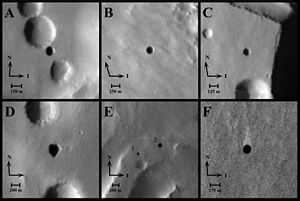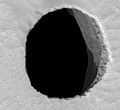Caves of Mars Project

The Caves of Mars Project was a program funded through Phase II by the NASA Institute for Advanced Concepts[1][2] to assess the best place to situate the research and habitation modules that a manned mission to Mars would require.[3]
Caves and other underground structures, including lava tubes, canyon overhangs, and other Martian cavities would be potentially useful for manned missions, for they would provide considerable shielding from both the elements and intense solar radiation that a Mars mission would expose astronauts to. They might also offer access to minerals, gases, ices, and any subterranean life that the crew of such a mission would probably be searching for.
The program also studied designs for inflatable modules and other such structures that would aid the astronauts to build a livable environment for humans and earth creatures.
-

HiRISE image of Mars hole "Jeanne", about 150 meters (492 feet) across and at least 178 meters (584 feet) deep.
-

HiRISE image of a 180 m wide lava tube skylight on the southeast flank of Pavonis Mons.
-

HiRISE image of a 35 m wide lava tube skylight surrounded by a collapse pit on Pavonis Mons.
References
- ↑ Robert Braun et al. (2009). Appendix E: List and Statistical Analysis of NIAC Grants. Fostering Visions for the Future: A Review of the NASA Institute for Advanced Concepts (National Academies Press). ISBN 0-309-14051-X. Retrieved 2010-06-30.
- ↑
- David, Leonard (2005-02-22). "Digging and Sniffing for Life on Mars". Space.com. Retrieved 2010-06-30.
- ↑ Boston, P.; Frederick, G.; Frederick, G.; Welch, S.; Werker, J.; Meyer, T.R.; Sprungman, B.; Hildreth-Werker, V.; Murphy, D.; Thompson, S.L. (2004), "System Feasibility Demonstrations of Caves and Subsurface Constructed for Mars Habitation and Scientific Exploration" (PDF), USRA Reports (NASA Institute for Advanced Concepts), retrieved 2010-06-30
- Notes
- Herbert W. Franke, "Höhlen auf dem Mars", Naturwissenschaftliche Rundschau 1998, Issue 5, page 169-175
- "Life in the Extremes: An Interview With Dr. Penelope Boston", 2000
- Radio interview on the caves with NASA scientists by Planetary Society.
External links
- The Caves of Mars Project
- Gallegos, Emma (2009-10-21). "Astrogeologists discover shallow caves that could provide shelter for life on Mars". Pasadena Star-News online. Retrieved 2009-10-25.
| |||||||||||||||||||
